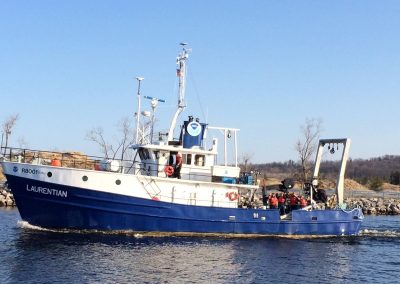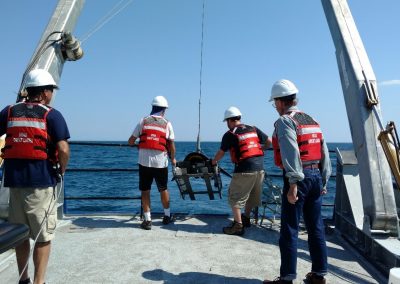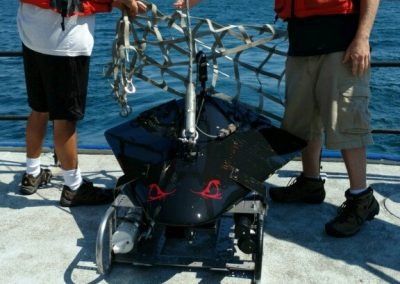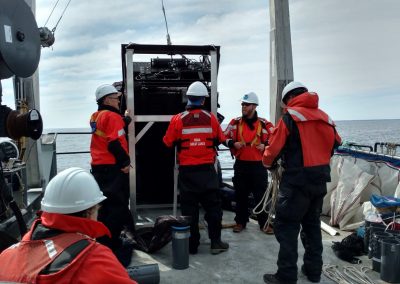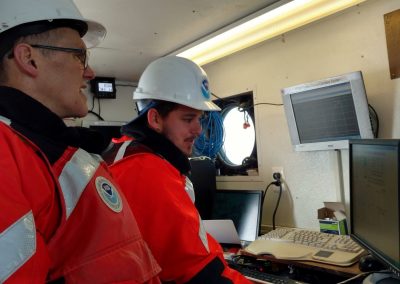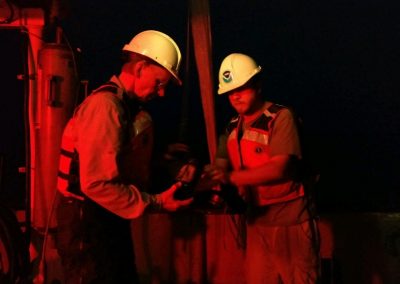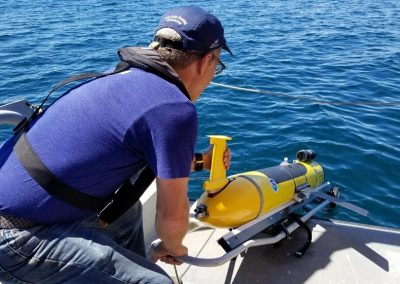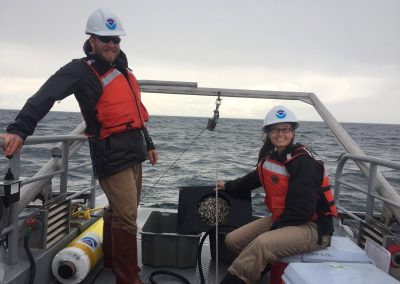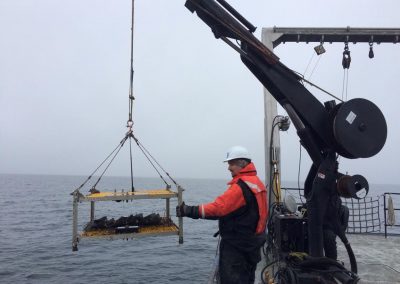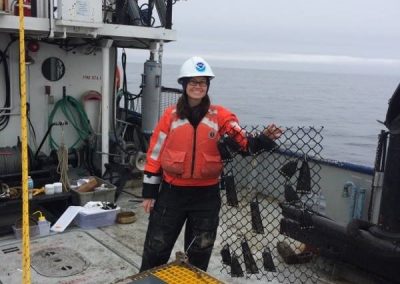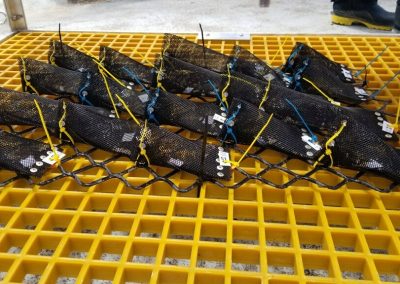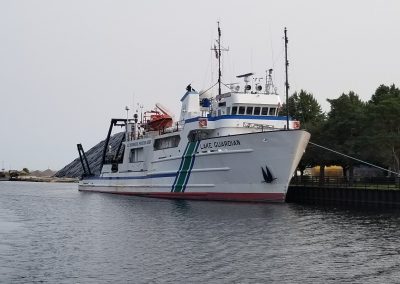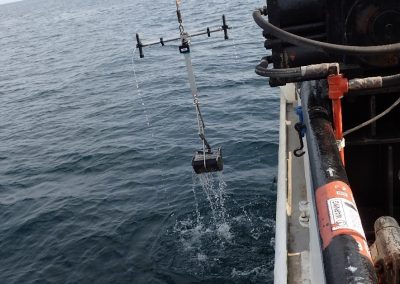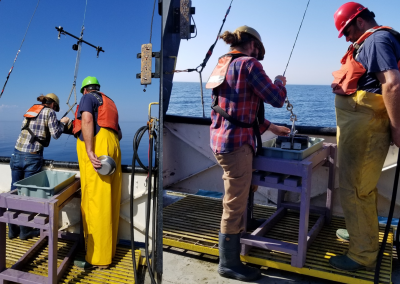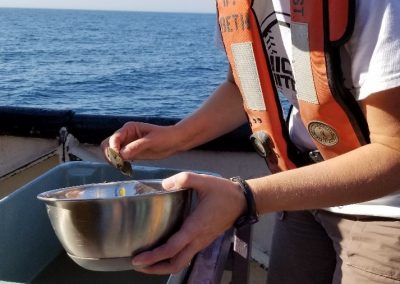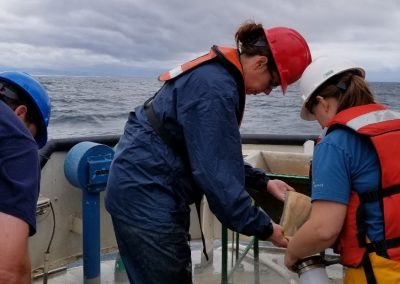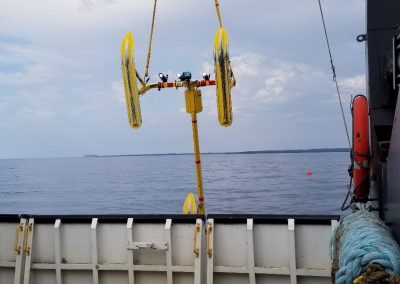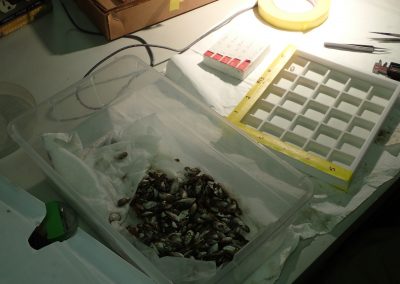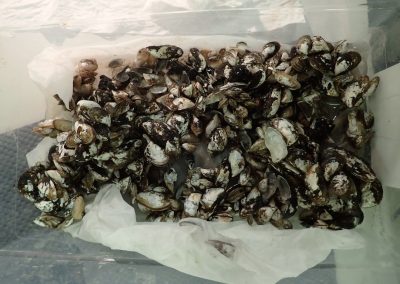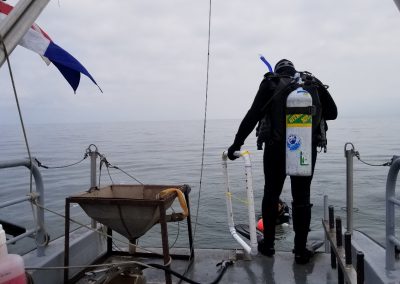Fall 2017 eNewsletter
Featured Research
Field Season Wrap-Up: Lake Huron Food Web Studies
CIGLR researchers had a busy field season on Lake Huron with our partners at the NOAA Great Lakes Environmental Research Laboratory (GLERL). Our work was part of the binational, multi-agency effort to study each of the Great Lakes on a rotational basis for the U.S. EPA-led Coordinated Science Monitoring Initiative (CSMI). After contributing to the CSMI in Lake Huron in 2012 and Lake Michigan in 2015, our team returned to Lake Huron in 2017 to take a major leadership role in defining the spatial structure of the whole food web (Fact sheet: Lake Huron Food Web). This information is critical to effectively manage invasive species, water quality, and fish production throughout the Great Lakes.
CIGLR researchers focused on three aspects of the Lake Huron CSMI to help define fine-scale food web structure, quagga mussel growth, and lake bottom characterization.
Fine-scale Food Web Study
Aboard the R/V Laurentian, we used both novel and traditional equipment to characterize the food web of Lake Huron vertically and horizontally. We collected samples around the clock and across seasons to capture changes in zooplankton, larval fish, and chlorophyll (algal pigment) in nutrient-rich Saginaw Bay and nutrient-poor Thunder Bay. We complemented our traditional sampling techniques like net tows and water grab samples with advanced technology, including the Plankton Survey System’s laser optical plankton counter, fisheries acoustics, and the Multiple Opening-Closing Net Environmental Sampling System that collects larval fish and zooplankton at targeted depths. We also deployed a Slocum glider for sixteen weeks to autonomously measure the water temperature, chlorophyll, and light data needed for modeling the influence of nutrients on the food web. This study will improve our understanding of Lake Huron predator-prey relationships, identify long-term trends in ecosystem food web health, and inform whole-lake ecological forecasts.
The R/V Laurentian is an 80 foot steel-hulled vessel operated by the NOAA Great Lakes Environmental Research Laboratory. The ship is equipped with wet and dry lab space an updated sampling equipment allowing scientists to collect a suite of samples from Lake Huron vertically and horizontally. Photo Credit: Joann Cavaletto.
The Plankton Survey System (PSS) is a submersible V-Fin (vehicle for instrumentation) that is towed behind the Laurentian. The PSS measures zooplankton, chlorophyll (a measure of phytoplankton), dissolved oxygen, temperature, and light levels from the surrounding water. L-R: Todd Roetman (GLERL), Dave Wells (CIGLR), Paul Glyshaw (CIGLR), and Hank Vanderploeg (GLERL). Photo Credit: Joann Cavaletto.
The Plankton Survey System (PSS) collects data throughout the water column at the same time fishery acoustic data are also collected. Together, these two instruments capture a large portion of the lake food web. Pictured L-R: Dave Wells (CIGLR) and Paul Glyshaw (CIGLR). Photo Credit: Joann Cavaletto.
The MOCNESS (Multiple Opening/Closing Net and Environmental Sensing System) is an instrument that samples the water column at targeted depths for zooplankton, inlcuding larval fish and the crustaceans Mysis and invasive Bythotrephes. Pictured L-R: Todd Roetman (GLERL), Ed Rutherford (GLERL), David Wells (CIGLR), Paul Glyshaw (CIGLR), and Doran Mason (GLERL). Photo Credit: Joann Cavaletto.
Ed Rutherford (GLERL) and David Wells (CIGLR) controlling the MOCNESS. As the MOCNESS tows behind the research vessel, each net can be opened and shut independently so that it samples a distinct patch of water. The researcher chooses exactly when to open and shut the net by using the environmental sensing system. This is an array of sensors mounted on the instrument frame that relays water conditions up to the ship in real time. Photo Credit: Joann Cavaletto.
Hank Vanderploeg (GLERL) and Paul Glyshaw (CIGLR) sampling and preserving zooplankton at night on Lake Huron. Samples were taken during day and night to mark changes that occurred in the zooplankton communities over that time. Photo Credit: Joann Cavaletto.
Mussel Growth Experiments
As part of a team led by Dr. Ashley Elgin (GLERL), we conducted growth experiments on the invasive quagga mussel in nutrient-rich Saginaw Bay and nutrient-poor Thunder Bay. Hundreds of quagga mussels were collected, measured, and placed into mesh cages at depths ranging from 40 to 300 feet. The cages were positioned on moorings that included thermistors to monitor temperature changes and fluorometers to monitor changes in food availability. This field experiment will allow us to identify how quagga mussel growth differs between areas with different nutrient inputs and compare growth rates between Lake Huron and Lake Michigan, where similar studies have been previously conducted.
Ashley Elgin (GLERL) and Paul Glyshaw (CIGLR) on Lake Huron preparing for the quagga mussel growth field experiment. Photo Credit: GLERL.
Aaron Dunnuck (GLERL) bringing in the mooring used for the quagga mussel growth experiment. The mesh mussel cages are shown secured to the bottom portion of the yellow grate. Photo Credit: Paul Glyshaw.
Ashley Elgin (GLERL) showing the mesh cages removed from the quagga mussel growth mooring. Photo Credit: Paul Glyshaw.
Lake Bottom (Benthic) Surveys
We spent two weeks in September surveying the bottom of the entire lake aboard the EPA’s R/V Lake Guardian (the largest research vessel in the Great Lakes!). We visited over 100 sites in the main basin of Lake Huron, Georgian Bay, and the North Channel with collaborators from EPA’s Great Lakes National Program Office (GLNPO) and the Great Lakes Center at Buffalo State College. At each site we collected samples for sediment-dwelling organisms, sediment characterization and nutrient analysis, and invasive mussel biomass. At select sites we went under the water to get a closer view of zebra and quagga mussel population densities. To estimate the bottom patchiness and coverage by mussels we collected video from a GoPro attached to a towed benthic sled. We also partnered with NOAA Thunder Bay National Marine Sanctuary divers to get a closer view of zebra and quagga mussel population densities on hard surfaces in Saginaw and Thunder Bay. These surveys will allow us to update the densities of mussels and other benthic organisms in Lake Huron.
The R/V Lake Guardian is the U.S. EPA’s largest research and monitoring vessel. The ship sails among all five of the Great Lakes and was used for the 2017 CSMI benthic survey. Photo Credit: Paul Glyshaw.
Hoisting a sediment sample collected with a ponar grab sampler back to the deck. Photo Credit: Paul Glyshaw.
Owen Stefaniak (EPA) and Glenn Carter (CIGLR) retrieving and emptying lake bottom sediment from a ponar grab sampler. Photo Credit: Paul Glyshaw.
Owen Stefaniak (EPA) retrieves another sediment sample while Glenn Carter (CIGLR) examines the contents of a previous sample. Photo Credit: Paul Glyshaw.
Beth Hinchey-Malloy (EPA GLNPO) takes a sediment sample to collect data for nutrients and grain size analysis. Photo Credit: Paul Glyshaw.
Beth Hinchey-Malloy (EPA GLNPO) and Katie Hastings (Buffalo State Great Lakes Center) finish rinsing and separating a Lake Huron sediment sample and place the contents in a jar to analyze later. Photo Credit: Paul Glyshaw.
A benthic sled was equipped with a Go Pro and towed behind the R/V Lake Guardian help estimate zebra and quagga mussel population densities. Photo Credit: Paul Glyshaw.
Wayne Lusardi (NOAA TBNMS) preparing to collect mussels in Saginaw Bay. The diver is holding a square quadrat to isolate a standard-size sampling area. Photo Credit: Paul Glyshaw.
About the Project
CSMI research in Lake Huron was led by GLERL Research Scientists Hank Vanderploeg, Ed Rutherford, Ashley Elgin, Steve Pothoven and Doran Mason and supported by Joann Cavaletto (GLERL), David Wells (CIGLR), Michele Wensman (CIGLR), Glenn Carter (CIGLR), Kerrin Mabrey (CIGLR), Russ Miller (CIGLR), Jeff Elliot (GLERL) and Aaron Dunnuck (GLERL). The Great Lakes Restoration Initiative, which is administered by the U.S Environmental Protection Agency (EPA), is funding this research. Scientists from the USGS Great Lakes Science Center, the Michigan Department of Natural Resources, and the University of Michigan are also participating in the Lake Huron CSMI.

